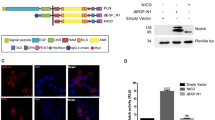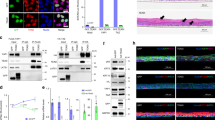Abstract
Physiological signalling by the epidermal growth factor receptor (EGFR) controls developmental processes and tissue homeostasis, whereas aberrant EGFR activity drives oncogenic cell transformation. Under normal conditions, the EGFR must therefore generate outputs of defined strength and duration. To this aim, cells balance EGFR activity via different modalities of negative signalling. Increasing attention is being drawn on transcriptionally controlled feedback inhibitors of EGFR, namely RALT/MIG6, LRIG1, SOCS4 and SOCS5. Genetic studies in mice have revealed the essential role of Ralt/Mig6 in regulating Egfr-driven skin morphogenesis and tumour formation, yet the mechanisms through which RALT abrogates EGFR activity are still undefined. We report that RALT suppresses EGFR function by inhibiting its catalytic activity. The evolutionarily conserved ErbB-binding region (EBR) is necessary and sufficient to carry out RALT-dependent suppression of EGFR kinase activityin vitro and in intact cells. The mechanism involves binding of the EBR to the 953RYLVIQ958 sequence, which is located in theαI helix of the EGFR kinase and has been shown to participate in allosteric control of EGFR catalytic activity. Our results uncover a novel mechanism of temporal regulation of EGFR activity in vertebrate organisms.
This is a preview of subscription content, access via your institution
Access options
Subscribe to this journal
Receive 50 print issues and online access
$259.00 per year
only $5.18 per issue
Buy this article
- Purchase on Springer Link
- Instant access to full article PDF
Prices may be subject to local taxes which are calculated during checkout







Similar content being viewed by others
References
Anastasi S, Fiorentino L, Fiorini M, Fraioli R, Sala G, Castellani L et al. (2003). Feedback inhibition by RALT controls signal output by the ErbB network. Oncogene 22: 4221–4234.
Anastasi S, Sala G, Huiping C, Caprini E, Russo G, Iacovelli S et al. (2005). Loss of RALT/MIG-6 expression in ERBB2-amplified breast carcinomas enhances ErbB-2 oncogenic potency and favors resistance to Herceptin. Oncogene 28: 4540–4548.
Ballaro C, Ceccarelli S, Tiveron C, Tatangelo L, Salvatore AM, Segatto O et al. (2005). Targeted expression of RALT in mouse skin inhibits epidermal growth factor receptor signalling and generates a waved-like phenotype. EMBO Rep 6: 755–761.
Baulida J, Kraus MH, Alimandi M, Di Fiore PP, Carpenter G . (1996). All ErbB receptors other than the epidermal growth factor receptor are endocytosis impaired. J Biol Chem 271: 5251–5257.
Bereziat V, Kasus-Jacobi A, Perdereau D, Cariou B, Girard J, Burnol AF . (2002). Inhibition of insulin receptor catalytic activity by the molecular adapter Grb14. J Biol Chem 277: 4845–4852.
Citri A, Yarden Y . (2006). EGF-ERBB signalling: towards the systems level. Nat Rev Mol Cell Biol 7: 505–516.
Di Fiore PP, Segatto O, Taylor WG, Aaronson SA, Pierce JH . (1990). EGF receptor and erbB-2 tyrosine kinase domains confer cell specificity for mitogenic signaling. Science 248: 79–83.
Ferby I, Reschke M, Kudlacek O, Knyazev P, Pante G, Amann K et al. (2006). Mig6 is a negative regulator of EGF receptor-mediated skin morphogenesis and tumor formation. Nat Med 12: 568–573.
Fiorentino L, Pertica C, Fiorini M, Talora C, Crescenzi M, Castellani L et al. (2000). Inhibition of ErbB-2 mitogenic and transforming activity by RALT, a mitogen-induced signal transducer which binds to the ErbB-2 kinase domain. Mol Cell Biol 20: 7735–7750.
Fiorini M, Alimandi M, Fiorentino L, Sala G, Segatto O . (2001). Negative regulation of receptor tyrosine kinase signals. FEBS Lett 490: 132–141.
Gur G, Rubin C, Katz M, Amit I, Citri A, Nilsson J et al. (2004). LRIG1 restricts growth factor signaling by enhancing receptor ubiquitylation and degradation. EMBO J 23: 3270–3281.
Hackel PO, Gishizky M, Ullrich A . (2001). Mig-6 is a negative regulator of the epidermal growth factor receptor signal. Biol Chem 382: 1649–1662.
Haslekas C, Breen K, Pedersen KW, Johannessen LE, Stang E, Madshus IH . (2005). The inhibitory effect of ErbB2 on epidermal growth factor-induced formation of clathrin-coated pits correlates with retention of epidermal growth factor receptor-ErbB2 oligomeric complexes at the plasma membrane. Mol Biol Cell 16: 5832–5842.
Hendriks BS, Opresko LK, Wiley HS, Lauffenburger D . (2003). Coregulation of epidermal growth factor receptor/human epidermal growth factor receptor 2 (HER2) levels and locations: quantitative analysis of HER2 overexpression effects. Cancer Res 63: 1130–1137.
Hsu CY, Hurwitz DR, Mervic M, Zilberstein A . (1991). Autophosphorylation of the intracellular domain of the epidermal growth factor receptor results in different effects on its tyrosine kinase activity with various peptide substrates. Phosphorylation of peptides representing Tyr(P) sites of phospholipase C-gamma. J Biol Chem 266: 603–608.
Huse M, Kuriyan J . (2002). The conformational plasticity of protein kinases. Cell 109: 275–282.
Kario E, Marmor MD, Adamsky K, Citri A, Amit I, Amariglio N et al. (2005). Suppressors of cytokine signaling 4 and 5 regulate epidermal growth factor receptor signaling. J Biol Chem 280: 7038–7048.
Kochupurakkal BS, Harari D, Di Segni A, Maik-Rachline G, Lyass L, Gur G et al. (2005). Epigen, the last ligand of ErbB receptors, reveals intricate relationships between affinity and mitogenicity. J Biol Chem 280: 8503–8512.
Laederich MB, Funes-Duran M, Yen L, Ingalla E, Wu X, Carraway III KL et al. (2004). The leucine-rich repeat protein LRIG1 is a negative regulator of ErbB family receptor tyrosine kinases. J Biol Chem 279: 47050–47056.
Lenferink AE, Pinkas-Kramarski R, van de Poll ML, van Vugt MJ, Klapper LN, Tzahar E et al. (1998). Differential endocytic routing of homo- and hetero-dimeric ErbB tyrosine kinases confers signaling superiority to receptor heterodimers. EMBO J 17: 3385–3397.
Longva KE, Blystad FD, Stang E, Larsen AM, Johannessen LE, Madshus IH . (2002). Ubiquitination and proteasomal activity is required for transport of the EGF receptor to inner membranes of multivesicular bodies. J Cell Biol 156: 843–854.
Luetteke NC, Phillips HK, Qiu TH, Copeland NG, Earp HS, Jenkins NA et al. (1994). The mouse waved-2 phenotype results from a point mutation in the EGF receptor tyrosine kinase. Genes Dev 8: 399–413.
Luetteke NC, Qiu TH, Peiffer RL, Oliver P, Smithies O, Lee DC . (1993). TGF alpha deficiency results in hair follicle and eye abnormalities in targeted and waved-1 mice. Cell 73: 263–278.
Marmor MD, Yarden Y . (2004). Role of protein ubiquitylation in regulating endocytosis of receptor tyrosine kinases. Oncogene 23: 2057–2070.
Miaczynska M, Pelkmans L, Zerial M . (2004). Not just a sink: endosomes in control of signal transduction. Curr Opin Cell Biol 16: 400–406.
Nicholson SE, Metcalf D, Sprigg NS, Columbus R, Walker F, Silva A et al. (2005). Suppressor of cytokine signaling (SOCS)-5 is a potential negative regulator of epidermal growth factor signaling. Proc Natl Acad Sci USA 102: 2328–2333.
Polo S, Pece S, Di Fiore PP . (2004). Endocytosis and cancer. Curr Opin Cell Biol 16: 156–161.
Ponzetto C, Bardelli A, Zhen Z, Maina F, dalla ZP, Giordano S et al. (1994). A multifunctional docking site mediates signaling and transformation by the hepatocyte growth factor/scatter factor receptor family. Cell 77: 261–271.
Schaefer G, Akita RW, Sliwkowski MX . (1999). A discrete three-amino acid segment (LVI) at the C-terminal end of kinase-impaired ErbB3 is required for transactivation of ErbB2. J Biol Chem 274: 859–866.
Schulze A, Lehmann K, Jefferies HB, McMahon M, Downward J . (2001). Analysis of the transcriptional program induced by Raf in epithelial cells. Genes Dev 15: 981–994.
Shelly M, Pinkas-Kramarski R, Guarino BC, Waterman H, Wang LM, Lyass L et al. (1998). Epiregulin is a potent pan-ErbB ligand that preferentially activates heterodimeric receptor complexes. J Biol Chem 273: 10496–10505.
Shilo BZ . (2003). Signaling by the Drosophila epidermal growth factor receptor pathway during development. Exp Cell Res 284: 140–149.
Sigismund S, Polo S, Di Fiore PP . (2004). Signaling through monoubiquitination. Curr Top Microbiol Immunol 286: 149–185.
Sigismund S, Woelk T, Puri C, Maspero E, Tacchetti C, Transidico P et al. (2005). Clathrin-independent endocytosis of ubiquitinated cargos. Proc Natl Acad Sci USA 102: 2760–2765.
Stamos J, Sliwkowski MX, Eigenbrot C . (2002). Structure of the epidermal growth factor receptor kinase domain alone and in complex with a 4-anilinoquinazoline inhibitor. J Biol Chem 277: 46265–46272.
Wiley HS, Shvartsman SY, Lauffenburger DA . (2003). Computational modeling of the EGF-receptor system: a paradigm for systems biology. Trends Cell Biol 13: 43–50.
Xu D, Makkinje A, Kyriakis JM . (2005). Gene 33 is an endogenous inhibitor of epidermal growth factor (EGF) receptor signaling and mediates dexamethasone-induced suppression of EGF function. J Biol Chem 280: 2924–2933.
Zhang X, Gureasko J, Shen K, Cole PA, Kuriyan J . (2006). An allosteric mechanism for activation of the kinase domain of epidermal growth factor receptor. Cell 125: 1137–1149.
Zhang YW, Staal B, Su Y, Swiatek P, Zhao P, Cao B et al. (2007). Evidence that MIG-6 is a tumor-suppressor gene. Oncogene 26: 269–276.
Acknowledgements
We thank V Federici for ERBB2/RALT co-IP studies, M Fanciulli, C Gaetano, A Musacchio, S Giordano, P Pisu, S Polo, Y Yarden and A Zingoni for reagents, PG Natali for support, L Sibilio for help with PDB analysis and R Fraioli for antibody purification. OS is supported by MIUR-FIRB, the Italian Ministry of Health and AIRC. S Alemà is supported by MIUR-FIRB and AIRC.
Author information
Authors and Affiliations
Corresponding authors
Additional information
Supplementary Information accompanies the paper on the Oncogene website (http://www.nature.com/onc).
Rights and permissions
About this article
Cite this article
Anastasi, S., Baietti, M., Frosi, Y. et al. The evolutionarily conserved EBR module of RALT/MIG6 mediates suppression of the EGFR catalytic activity. Oncogene 26, 7833–7846 (2007). https://doi.org/10.1038/sj.onc.1210590
Received:
Revised:
Accepted:
Published:
Issue Date:
DOI: https://doi.org/10.1038/sj.onc.1210590
Keywords
This article is cited by
-
Molecular insight into the affinity, specificity and cross-reactivity of systematic hepatocellular carcinoma RALT interaction profile with human receptor tyrosine kinases
Amino Acids (2021)
-
Suppression of Mig-6 overcomes the acquired EGFR-TKI resistance of lung adenocarcinoma
BMC Cancer (2020)
-
Panobinostat Enhances Growth Suppressive Effects of Progestin on Endometrial Carcinoma by Increasing Progesterone Receptor and Mitogen-Inducible Gene-6
Hormones and Cancer (2017)
-
Structure and mechanism of activity-based inhibition of the EGF receptor by Mig6
Nature Structural & Molecular Biology (2015)
-
A pervasive role for MIG6 in restraining cell proliferation
Cell Death & Differentiation (2014)



